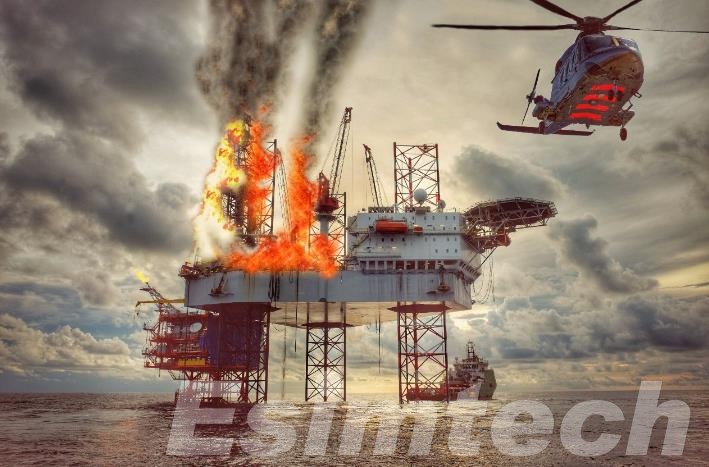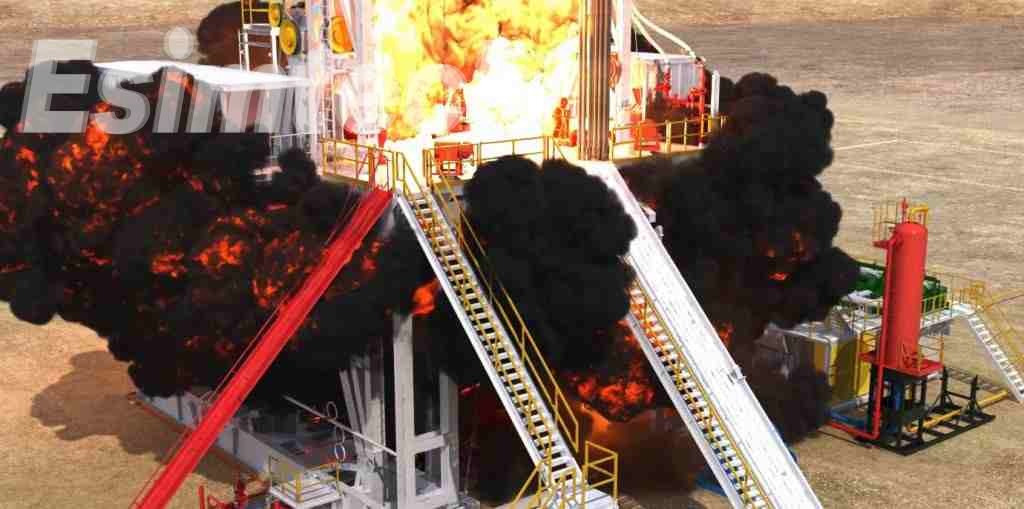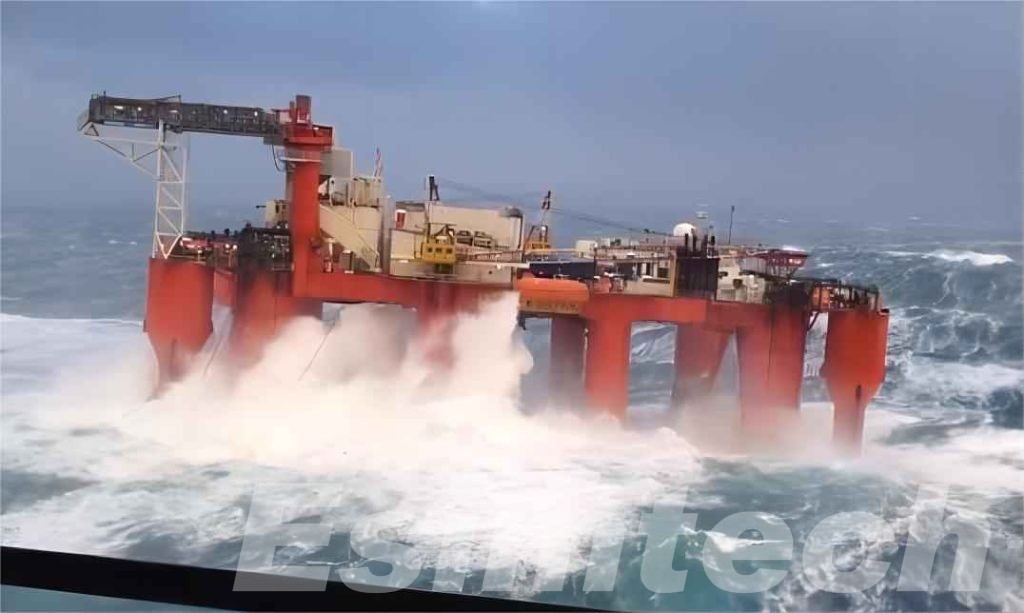Oil Rig Accidents: What are 5 Common Types and Why Select Simulation Training to Prevent Them
The offshore oil and gas industry is a critical component of the global energy supply chain, extracting vast reserves of hydrocarbons from beneath the ocean floor. While it plays a pivotal role in meeting the world’s energy needs, it is also fraught with inherent dangers. Oil rig accidents can lead to severe oil rig injuries, environmental disasters, and economic losses. In this article, we will delve into the various types of oil rig accidents and the injuries they can inflict upon workers.

Common Types of Oil Rig Accidents
Blowouts
One of the most feared occurrences in the offshore oil industry is a blowout. This catastrophic event unfolds when high-pressure oil or gas surges uncontrollably from the well. Blowouts can be triggered by equipment failures, human error, or a combination of factors, often leading to massive explosions.
Blowouts are often the result of a combination of factors, including equipment failure, human error, and inadequate safety measures. Equipment malfunctions, such as the failure of blowout preventers, which are designed to control and contain well pressures, can be a contributing factor. Additionally, human error in the operation of drilling and well control equipment plays a significant role in blowout incidents.
Oil rig injuries resulting from blowouts are typically severe and can include:
- Burns: The intense heat and fire that often accompany a blowout can cause extensive burns to workers. These burns can range from first-degree (superficial) burns to third-degree (full-thickness) burns, which can be life-threatening.
- Traumatic Injuries: The force of a blowout can throw workers off their feet or against equipment, causing traumatic injuries such as fractures, head injuries, and lacerations.
- Exposure to Toxic Gases: Blowouts can release not only oil and gas but also toxic gases. Exposure to these gases can lead to respiratory problems, chemical burns, and other health issues.
- Psychological Trauma: Workers who survive a blowout may experience psychological trauma due to the intense stress and life-threatening situations they encounter.
Fires and Explosions
Fires and explosions on oil rigs are another highly concerning risk. These incidents often result from equipment malfunctions, electrical faults, or human error. When fires and explosions occur on oil rigs, they can lead to extensive damage, including the potential destruction of the rig itself. Workers who find themselves in proximity to the source of these fires or explosions may suffer from severe burns, smoke inhalation, and traumatic injuries.
Fires and explosions on oil rigs are unpredictable and devastating. They can result from various causes, including:
- Equipment Malfunctions: The oil and gas industry relies heavily on complex machinery and equipment. When equipment fails or malfunctions, it can lead to the release of flammable substances, sparking fires or explosions.
- Electrical Faults: Electrical systems on oil rigs are susceptible to faults due to the harsh offshore environment. Electrical malfunctions can lead to electrical fires that can quickly spread.
- Human Error: Mistakes made during maintenance, operation, or the handling of flammable substances can lead to fires or explosions.
- Gas Leaks: Leaks of combustible gases, such as natural gas, can lead to explosions if they encounter an ignition source.

The oil rig injuries resulting from fires and explosions on oil rigs can be severe, and they may include:
- Burns: Severe burns are common in these incidents. The heat generated by fires and explosions can cause both thermal and chemical burns.
- Smoke Inhalation: Workers in the vicinity of a fire may inhale toxic smoke, leading to respiratory problems and other health issues.
- Traumatic Injuries: The force of an explosion can throw workers against hard surfaces or cause debris to strike them, leading to traumatic injuries.
- Psychological Trauma: Workers who survive these incidents often experience severe psychological trauma due to the life-threatening nature of fires and explosions.
Falls and Falling Objects
Oil rigs are towering, multi-level structures with various platforms, walkways, and equipment. As a result, workers are frequently at risk of falling from heights or being struck by falling objects. These accidents can cause a wide range of injuries, from broken bones to head injuries and spinal cord damage.
Working at heights on oil rigs is a common and necessary task, but it presents significant risks. Falls and falling objects accidents can occur due to a variety of factors, including:
- Slippery Surfaces: The presence of oil, water, or drilling mud on walkways and platforms can create slippery surfaces, increasing the risk of slips and falls.
- Unsecured Equipment: Failure to secure tools and equipment can result in them falling from heights and striking workers below.
- Lack of Guardrails and Safety Nets: Inadequate safety measures, such as missing guardrails or safety nets, can contribute to falls from elevated platforms.
- Weather Conditions: Adverse weather conditions, including high winds and rough seas, can make working at heights more dangerous.
- Human Error: Inadequate training or lapses in judgment can lead to accidents involving falls or falling objects.
Injuries resulting from falls and falling objects on oil rigs can include:
- Broken Bones: Falls from heights can result in fractures of the limbs, pelvis, or spine.
- Head Injuries: Falling objects can cause severe head injuries, including concussions and traumatic brain injuries.
- Spinal Cord Injuries: Falls from heights may lead to spinal cord injuries, potentially resulting in paralysis.
- Lacerations: Workers may suffer lacerations from being struck by falling objects or as a result of falls
Preventing falls and falling objects accidents requires a comprehensive safety approach. This includes training workers in fall prevention, providing appropriate personal protective equipment (PPE), and ensuring that walkways, platforms, and equipment are properly maintained and secured.
Weather-Related Incidents
Offshore oil rigs are exposed to the elements, and adverse weather conditions can pose a significant threat. Storms, hurricanes, high waves, and strong winds can lead to oil rig movements, damage, or even rig topples. Workers may experience injuries during these events, including injuries from being thrown or hit by debris.
Weather-related incidents in the offshore industry can include:
- Storms and Hurricanes: Powerful storms and hurricanes can create severe weather conditions that put rigs at risk of damage or instability.
- High Waves: Large waves, particularly in rough seas, can result in rig movements that can be dangerous to workers and equipment.
- Strong Winds: Strong winds can affect rig stability and may lead to movements or damage.

Oil rig Injuries resulting from weather-related incidents on oil rigs can include:
- Traumatic Injuries: Workers may be thrown off balance or struck by debris, resulting in traumatic injuries such as fractures and head injuries.
- Drowning: Severe weather can increase the risk of workers ending up in the water, making drowning a concern.
- Environmental Impact: Adverse weather conditions can lead to spills, accidents, and environmental damage.
Preventing weather-related incidents involves closely monitoring weather conditions, ensuring the stability of the rig in adverse conditions, and having emergency response plans in place to protect workers during storms and hurricanes.
Collisions and Groundings
In the offshore industry, collisions between vessels and oil rigs or groundings of rigs can lead to serious accidents. These incidents can result in structural damage to the rig and potential oil spills, causing environmental damage and loss of life.
Collisions and groundings involving oil rigs can occur for various reasons, including:
- Navigation Errors: Errors in navigation or communication between vessels and rigs can lead to collisions or groundings.
- Weather Conditions: Adverse weather, such as storms or heavy seas, can make navigation more challenging and increase the risk of accidents.
- Equipment Failures: Failures in navigation or positioning equipment can contribute to accidents.
- Human Error: Mistakes made by vessel operators or rig personnel can lead to collisions or groundings.
Injuries resulting from collisions and groundings on oil rigs can include:
- Traumatic Injuries: Workers and crew members aboard vessels involved in collisions may suffer from traumatic injuries, such as fractures, head injuries, and lacerations.
- Drowning: In the event of a rig grounding or vessel collision, workers or crew members may find themselves in the water, increasing the risk of drowning.
- Environmental Impact: Collisions and groundings can have severe environmental consequences, including the release of oil or other pollutants into the marine environment.

The Role of Simulation Training in Oil Rig Accidents
Preventing oil rig accidents and injuries requires a comprehensive approach, including the strict implementation of safety protocols, ongoing training, and the use of advanced technology. Simulation technology in the oil and gas industry is an efficient way that help people prevent accidents and injuries.
- Realistic Scenario Practice: It enables workers to practice realistic accident scenarios, helping them better understand the dynamics of various emergencies such as blowouts, fires, and machinery malfunctions.
- Preventative Measures: Simulation training aids in hazard recognition and understanding, equipping workers to take proactive measures to reduce the likelihood of accidents.
- Response Preparedness: It prepares workers for swift and effective responses in actual emergencies, guiding them through assessments, task prioritization, and necessary actions to mitigate accident impacts.
- Hands-On Experience: Simulation training provides practical, hands-on experience, boosting confidence and competence in operating equipment, using safety gear, and applying protocols.
- Environmental Protection: Simulation training extends to minimizing environmental damage in the event of accidents, ensuring that workers can contain pollutants and protect the surrounding ecosystem.
Conclusion
In conclusion, the offshore oil and gas industry is essential for meeting global energy demands but carries significant risks. Understanding these risks is crucial for improving safety measures. Collaboration between rig operators, workers, and regulatory bodies is essential to minimize these risks and ensure the safety of those working in this high-stakes environment. This collective effort helps protect lives, the environment, and the industry’s future.
